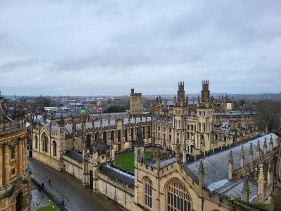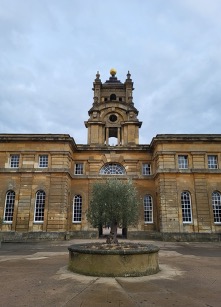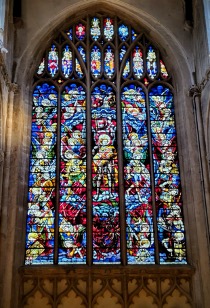Faith, Stories, and Architecture in Oxford

Ally McAfee
Creator of all things,
true Source of light and wisdom,
lofty origin of all being,
graciously let a ray of Your brilliance
penetrate into the darkness of my understanding
and take from me the double darkness
in which I have been born,
an obscurity of both sin and ignorance.
Give me a sharp sense of understanding,
a retentive memory,
and the ability to grasp things correctly and fundamentally.
Grant me the talent of being exact in my explanations,
and the ability to express myself with thoroughness and charm.
Point out the beginning,
direct the progress,
and help in completion;
through Christ our Lord.
Amen.
—St. Thomas Aquinas
Every morning spent in Oxford began with Thomas Aquinas’ “Prayer Before Study” as we prepared to learn and accept the wisdom offered up by the day. Having placed ourselves in an environment of soaring gothic cathedrals and grand libraries, my classmates and I were surrounded on every side by the pursuit of knowledge embodied in stone.
On our first day, after a brief overview of Oxford University’s history, Dr. Clark led us out into the city for what he termed a “literary appetizer.” We walked through the various colleges that make up the university as Dr. Clark pointed out landmarks such as the Martyrs Monument and towers beloved by C.S. Lewis. Dr. Clark commented on the work of architect Sir Christopher Wren, the activities of J.R.R. Tolkien, and the peculiar position of the university in society.
History of Oxford
The city of Oxford, made up of various colleges, is built from golden-hued Headington Limestone. Many of the buildings are in the Gothic Revival style, with tall, pointed arches, and colorful stained-glass windows. The architect Augustus Pugin famously considered gothic the only truly Christian architecture and thus the only acceptable style in which to build. The limestone, coveted for its rich tones and malleable texture, is soft and crumbles easily, resulting in a city and university that is constantly being restored and repaired. Time wears down all efforts of human legacy until the statues of heroes are faceless, yet there is a beauty in the soft destruction of the ages as it exposes the tender preservation and respect of the past in the face of inevitable change.
Oxford University began as a monastery by the river, and the Christian roots of the modern colleges run deep as seen in the gorgeous chapels present in every college. The centrality of Oxford as both an intellectual and spiritual center in the Oxford Movement and the literary spheres of England allowed me to experience Oxford’s unique position and nature was a wonderful opportunity as a Christian student. Oxford allows an easier intermingling of faith and study, and an aid in understanding the way that each affects the other as time progresses.
The Cauldron of Story
One day, after attending a church service, a small group of students, including myself, climbed up the tower of St. Mary the Virgin Cathedral (where C.S. Lewis used to speak). The tower was reached by climbing 127 steps of medieval spiral stairs, and the city below was a jagged combination of old and new buildings in a mingled timeline across the sky. The university has undergone many changes and evolutions, even as it cradles antiquity, in a manner aptly reflective of humanity’s increasing knowledge and perceptions.
One morning class time was focused on J.R.R. Tolkien’s essay “On Fairy Stories.” The discussion delved into an exploration of Tolkien’s theory of ‘the Cauldron of Story.’ The cauldron is an allegory of sorts, in which a soup pot could be seen as a representation of the way that ideas and stories are generated, as each spoonful of a storyteller plucks out a few ingredients of the whole. The cauldron swirls together history, legends, hopes and fears—and all manner of things that influence each other and the overall flavor of each bite—into a collective imagination, from which we are able to create a story that is at once brand new, and as old as time.
Stories in Oxford
The academic activities of our class, for me, kept the Cauldron of Story on my mind throughout the entire course. During the month-long trip, we read works by Tolkien, and essays on John Henry Newman, Edward Bouverie Pusey, and Augustus Pugin. We focused on their relationship with the Oxford Movement and, in the case of Newman and Pusey, the writing of religious Tracts. For a class on imagination, and one that we prepared for by reading The Hobbit and The Lion, the Witch, and the Wardrobe, some of the reading selections may seem out of place. However, the works and beliefs of Newman, Pusey, and Pugin influenced the intellectual culture of Oxford University, and inspired writers like Tolkien and Lewis thus adding to the Cauldron of Story from which they withdrew their themes, their words, and their characters.
I found our studies to be most fascinating because I’m interested in the origin, construction, and intricacies of storytelling. Even our class discussion on Pugin’s strong opinions on architecture struck a chord with my intellectual attachment to stories. Gothic architecture was created during the Middle Ages as a design distinct and separate from classical architecture, it was unconnected to the pagan societies of ancient Greece and Rome, and thus, in his mind, of a greater capacity to honor God. The influences of stories are everywhere, in every piece of art or history or inspiration. At the end of the day, this trip has reminded me that stories shape who we are, and how we think, and push us to pursue knowledge and wisdom with the fervor to make the places in which they are studied and created some of the loveliest on earth.



